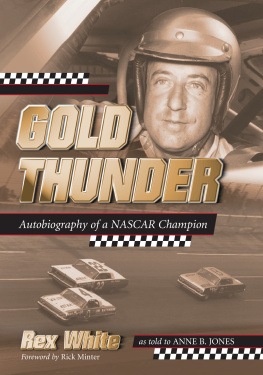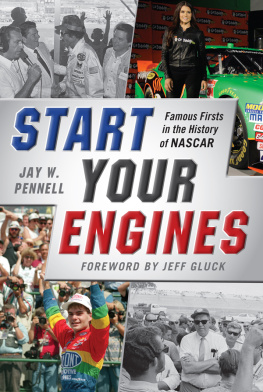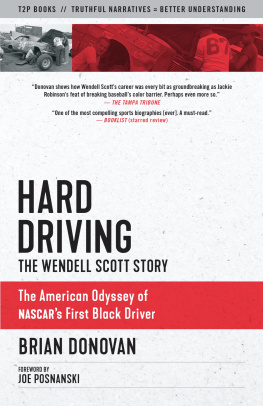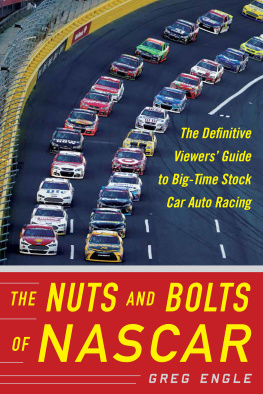Parts of this book have been reprinted with permission in revised form from The Most Southern Sport on Earth: NASCAR and the Unions, Southern Cultures 7, no. 2 (2001): 833, and Bib Overalls and Bad Teeth: Stock Car Racing and the Piedmont Working Class, Atlanta History 46, no. 2 (2004): 2641.
The paper in this book meets the guidelines for permanence and durability of the Committee on Production Guidelines for Book Longevity of the Council on Library Resources. The University of North Carolina Press has been a member of the Green Press Initiative since 2003.
Illustrations
Steamer moonshine still in McDuffie County, Georgia, 1953 or 1954
Fonty Flock and Red Byron power-slide through the turns in their flat-head Ford V-8s
Open-wheel, big-car race in 1947 at Atlantas Lakewood Speedway
One of Jack Kochmans Hell Drivers performs a stunt
Late 1940s Daytona beach/road race
Bill France in his early days as a stock car driver on Daytona Beach
Stock car race at Lakewood Speedway
Robert Red Byron after a victory at a 1949 race at Martinsville, Virginia
Bill France and others at NASCAR headquarters in Daytona Beach in 1954
The Mad Flocks
Typical scene of mayhem in the early days of NASCAR at a modified race at Daytona
Louise Smith before a race
Frightening crash at Lakewood Speedway in 1949
Fonty Flock prepares for the Daytona Beach race in 1955
The pace car leads seventy-five cars down the front stretch for the first Southern 500 at Darlington Raceway
Marshall Teague stands next to his Fabulous Hudson Hornet with pioneer car owner Raymond Parks
Lee Petty
Bill France with wife Anne and sons Bill Jr. and Jim at a Daytona Beach Chamber of Commerce dinner honoring Big Bill in 1955
Carl Kiekhaefer stands next to his four entries before a 1956 race at Asheville-Weaverville Speedway
Curtis Turner takes the green flag to start a timed speed run on Daytona Beach in one of Charlie Schwams purple Ford Wild Hogs
Joe Weatherly and Curtis Turner in a NASCAR Convertible Series race at McCormick Field in Asheville, North Carolina
Ned Jarrett
Big Bill France and Curtis Turner, with daredevil aviatrix and test driver Betty Skelton, mid-1950s
Junior Johnson after the Grand National race at Asheville-Weaverville Speedway in August 1961
Fireball Roberts
Wendell Scott stands next to his #34 Ford before a race at North Wilkesboro in April 1966
The Wood brothers revolutionized the NASCAR pit stop, turning it into an athletic ballet
Richard Petty takes a victory lap at Darlingtons 1967 Southern 500
Bill France confronts Richard Petty and other drivers over the Professional Drivers Association decision to boycott the first Talladega race
Bobby Isaac with legendary crew chief Harry Hyde
REAL NASCAR
Introduction
In the Beginning There Was Bristol
I grew up within earshot of the Asheville Speedwayor New Asheville as it was generally called in my childhood yearsthe local bastion of stock car racing. Like most Ashevillians who were not race fans, I considered the Friday night races noisy nuisances and the people who frequented the track rednecks. My opinion of racing and race fans did not change appreciably over the years, not even when my potluck roommate at Western Carolina University and soon-to-be best friend, Don Good, turned out to be a die-hard stock car racing fan whose fondest memories were of weekends spent camping with his truck driver father, Wayne, in the infield of the Charlotte Motor Speedway. Indeed, I doubt whether I ever saw more than a few minutes of a televised race, and I knew little about the sport other than having a passing knowledge of the on-track exploits of Richard Petty (I did grow up in North Carolina) and Darrell Waltrip (I happened to be teaching school in a town near Waltrips Franklin, Tennessee, home when he was winning championships in Junior Johnsons car in the 1980s).
All of that changed on August 27, 1994, when Don, now a college professor and administrator, convinced me to go with him to the night Winston Cup race at Bristol Motor Speedway. As a southern historianand also as an individual in his late thirties who had quit trying to run from his redneck rootsI felt I owed it to myself to see at least one race, so I agreed to go. Unbeknownst to me, the race Don had invited me to attend was, and still is, generally considered the most exciting race on the NASCAR circuit and the toughest ticket to acquire. It is hard to describe what I encountered on that August night. I was astounded by the sight of all the souvenir trailers around the track and the obvious loyalty of the fans, almost all attired in colorful T-shirts and hats announcing their allegiance to a favorite driver. The strange mixture of smells was equally overwhelming: an olio of carnival food, sweat, exhaust fumes, burning rubber, and high-octane gasoline.
At the time, the track held 70,000 or so fans, and it was jammed; even the grassy bank at the exit of the fourth turn was full of folks sitting on blankets. I lost count at more than one hundred as we climbed the seemingly innumerable steps of the new aluminum grandstand on the backstretch near the entrance to turn three. The rows of brightly colored team race car haulerspainted to match the paint job on the carsparked in the infield added to the carnival scene. As the race neared, my anticipation grew when the crowd rose and a pastor delivered an invocation. After the invocation, Lee Greenwood sang God Bless the U.S.A.I cannot count the number of races I have been to where Greenwood sang this songand the national anthem, and the fans roared their approval of an earsplitting flyover of air force jets in tight formation. The excitement of the fans intensified as the cars lined up on pit road and someone gave the command Gentlemen, start your engines. I did not anticipate how loud the cars would be; in fact, I could barely communicate with Don over the unmuffled roar of the engines. The pace car pulled out onto the track followed by the brightly colored race cars, waxed to a high sheen to reflect the track lights. Seemingly all 70,000 fans inside the track rose to their feet in anticipation of the green flag.
When the green flag flew, the decibel level jumped tenfold. I had never heard anything like this assault on my eardrums in my life. Now I understood why people around me were wearing earplugs. Bristol Motor Speedway is a particularly loud facility, as the grandstands completely enclose the .533-mile track, which in turn sits in a bowl in the surrounding hills. You could literally feel the sound. After 5 lapsof a total 500I knew I would never last the race without earplugs. Fortunately, the ends of the strap that I had on my sunglasses fit into my ears perfectly and muffled the sound. When I later asked Don why he did not warn me about the intense noise, he told me that he believed you had not really been to the races unless your ears rang for two or three days afterward. I will say I have chosen to forgo that particular racing pleasure.







